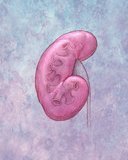Toxic Nephropathy: Treatment

Toxic nephropathy is characterized as a specific kidney damage due to acute exotoxicosis( poisoning).The most common exotoxicosis is poisoning with all possible nephrotoxic substances such as mercury, chromium, oxalic acid, lead and arsenic. This includes poisoning associated with hemolytic substances such as acetic acid, copper sulfate, etc. When poisoning develops toxic damage to the liver, and then follows a violation of kidney function.
There is also a nonspecific lesion of the kidneys, which in turn is manifested due to severe poisoning with all sorts of poisons or in hemodynamic disorders. The most, perhaps, terrible indicator, arising when the kidneys are affected, is the appearance of the syndrome of positional compression, which is caused by the appearance of severe complications in the form of coma.
Symptoms and treatment of toxic nephropathy
Nephropathy toxic has three degrees and each is characterized by its symptoms. For an easy degree of disease, the appearance of protein in the urine, as well as elements of blood. The average degree is characterized by the appearance of protein and blood in the urine, and a decrease in diuresis, a slight increase in urea, potassium and creatinine. The last third degree is characterized by the onset of acute renal failure, which in turn is divided into three phases: initial, oligoanuric and polyuric. The initial phase lasts from 1 to 3 days and is accompanied by signs of acute poisoning. The second oligoanuric phase proceeds from seven to fourteen days and has severe consequences in the form of an overload of the left ventricle, the emergence of the syndrome of "wet lungs", the appearance of shortness of breath, wet wheezing, up to the appearance of edema, both the lungs and the brain. In the body, there is accumulation of slags and products of protein metabolism in the form of creatinine, urea. All this is accompanied by the appearance of weakness, retardation, comes intoxication with potassium, which in turn can cause heart failure. The third polyuric phase in the presence of a favorable course of the disease smoothly turns into polyuria, which in turn can lead to both dehydration and hypo-salemia. This phase can last several years.
The process of recovery is characterized by a gradual increase in the specific gravity of urine, as well as the normalization of homeostasis, the process can last from six months to two, three years.
With respect to mortality in acute renal failure, it varies between twenty and seventy percent, depending on the etiological factors.
Toxic nephropathy, the treatment of which can also consist of several options depending on the phases and the degree of the disease. First of all, the treatment of nephropathy includes, so-called etiologic treatment, which is prophylactic in nature and effective in the first hours of manifestation of the disease. In severe cases of poisoning with dichloroethane an important role is played by measures aimed at excretion of the poison in the first hours, which gives positive results and excludes the appearance of negative complications.
If there is poisoning with hepatoxic substances, the necessary condition for the treatment of toxic nephropathy is the combination of several therapeutic measures: gastric lavage, which is accompanied by the further introduction of vaseline oil + adsorbent;Carrying out hemodialysis for a period of five to six hours;Carrying out peritoneal dialysis lasting up to two days.
Also effective is the procedure of forced diuresis with mandatory use of osmotic diuretics. This measure will increase the osmolality of the epithelium in the tubule of the kidneys to the state of complete functional hydropy, and also reduce the resorptive function of the epithelium and protect the possibility of gross damage from amino acids and nephrotoxins, which in turn are excreted by the damaged liver.



